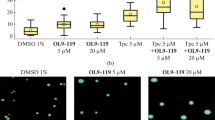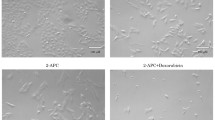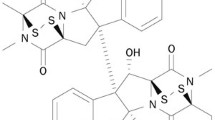Abstract
Purpose
The importance of understanding the mechanism of action of anticancer agents is sometimes overlooked in the pursuit of new and therapeutically advantageous compounds. Doxorubicin has long been identified as an inhibitor of the DNA-decatenating enzyme topoisomerase II, this being believed to be the major mechanism of action of this drug. However, the complex nature of cytotoxicity induced by doxorubicin suggests that more than one mechanism of action is responsible for cell kill. Investigation into various other cellular effects has shown that doxorubicin can, in the presence of formaldehyde, form doxorubicin-DNA adducts, resulting in enhanced cell death.
Methods
We have used six catalytic inhibitors of topoisomerase II (aclarubicin, merbarone, suramin, staurosporine, maleimide and sobuzoxane) to investigate the role of topoisomerase II mediated cell effects in doxorubicin-DNA adduct inducing treatments. Adduct levels were determined by scintillation counting of [14C]doxorubicin-DNA lesions and DNA damage responses by Comet analysis and flow cytometry (apoptosis).
Results
Here we show that sobuzoxane inhibits topoisomerase II but in the presence of doxorubicin also enhances the production of doxorubicin-DNA adducts resulting in an enhanced cytotoxic response. We show that the formation of doxorubicin-DNA adducts is mediated by formaldehyde released from sobuzoxane when it is metabolised.
Conclusions
Sobuzoxane has also been shown to decrease the normally dose limiting cardiotoxicity commonly exhibited with clinical use of doxorubicin. The potential combination of doxorubicin and sobuzoxane in cancer chemotherapy has two advantages. First, the mechanism of doxorubicin toxicity is shifted away from topoisomerase II inhibition and towards drug-DNA adduct formation which may allow for a lower drug dose to be used and circumvent some drug resistance problems. Second, the addition of a cardioprotecting agent will counteract the commonly dose limiting side effect of cardiac damage resulting from doxorubicin treatment. The importance of the potentiation of cell kill of doxorubicin and sobuzoxane provides a rationalisation of a mechanistic-based combination of anticancer drugs for an improved clinical outcome.






Similar content being viewed by others
References
DeVita VT, Hellman S, Rosenberg SA (eds) (2005) Cancer: principles & practice of oncology. Lippincott Williams and Wilkins, Philadelphia
Taatjes DJ, Gaudiano G, Resing K, Koch TH (1997) Redox pathway leading to the alkylation of DNA by the anthracycline, antitumor drugs Adriamycin and daunomycin. J Med Chem 40:1276–1286
Doroshow JH (1995) Role of reactive-oxygen metabolism in cardiac toxicity of anthracycline antibiotics. In: Priebe W (ed) Anthracycline antibiotics: new analogues, methods of delivery, and mechanisms of action. American Chemical Society, Washington, DC, pp 259–267
Berman E, McBride M (1992) Comparative cellular pharmacology of daunorubicin and idarubicin in human multidrug-resistant leukemia cells. Blood 79:3267–3273
Gewirtz DA (1999) A critical evaluation of the mechanisms of action proposed for the antitumor effects of the anthracycline antibiotics adriamycin and daunorubicin. Biochem Pharmacol 57:727–741
Cutts SM, Swift LP, Rephaeli A, Nudelman A, Phillips DR (2005) Recent advances in understanding and exploiting the activation of anthracyclines by formaldehyde. Curr Med Chem Anti-Cancer Agents 5:431–447
Liu LF (1989) DNA topoisomerase poisons as antitumor drugs. Annu Rev Biochem 58:351–375
Pommier Y (1995) DNA Topoisomerases and their inhibition by anthracyclines. Anthracycline antibiotics: new analogues, methods of delivery, and mechanisms of action. American Chemical Society, Washington, DC, pp 183–203
Sordet O, Khan QA, Kohn KW, Pommier Y (2003) Apoptosis induced by topoisomerase inhibitors. Curr Med Chem Anti-Cancer Agents 3:271–290
Zunino F, Capranico G (1990) DNA topoisomerase II as the primary target of anti-tumor anthracyclines. Anticancer Drug Des 5:307–317
Wang J, Gao YG, Liaw CY, Li YK (1991) Formaldehyde cross-links daunorubicin and DNA efficiently: HPLC and X-ray diffraction studies. Biochemistry 30:3812–3815
Fenick DJ, Taatjes DJ, Koch TH (1997) Doxoform and daunoform: anthracycline-formaldehyde conjugates toxic to resistant tumor cells. J Med Chem 40:2452–2461
Zeman SM, Phillips DR, Crothers DM (1998) Characterization of covalent Adriamycin-DNA adducts. Proc Natl Acad Sci USA 95:11561–11565
Cullinane C, Cutts SM, Panousis C, Phillips DR (2000) Interstrand cross-linking by Adriamycin in nuclear and mitochondrial DNA of MCF-7 cells. Nucleic Acids Res 28:1019–1025
Swift LP, Rephaeli A, Nudelman A, Phillips DR, Cutts SM (2006) Doxorubicin-DNA adducts induce a non-topoisomerase II-mediated form of cell death. Cancer Res 66:4863–4871
Nudelman A, Levovich I, Cutts SM, Phillips DR, Rephaeli A (2005) The role of intracellularly released formaldehyde and butyric acid in the anticancer activity of acyloxyalkyl esters. J Med Chem 48:1042–1054
Swift LP, Cutts SM, Rephaeli A, Nudelman A, Phillips DR (2003) Activation of adriamycin by the pH-dependent Formaldehyde-releasing prodrug hexamethylenetetramine. Mol Cancer Ther 2:189–198
Berger JM, Gamblin SJ, Harrison SC, Wang JC (1996) Structure and mechanism of DNA topoisomerase II. [erratum appears in Nature 1996 Mar 14;380(6570):179]. Nature 379:225–232
Moro S, Beretta GL, Dal Ben D, Nitiss J, Palumbo M, Capranico G (2004) Interaction model for anthracycline activity against DNA topoisomerase II. Biochemistry 43:7503–7513
Liu LF, Rowe TC, Yang L, Tewey KM, Chen GL (1983) Cleavage of DNA by mammalian DNA topoisomerase II. J Biol Chem 258:15365–15370
Larsen AK, Escargueil AE, Skladanowski A (2003) Catalytic topoisomerase II inhibitors in cancer therapy. Pharmacol Ther 99:167–181
Jensen PB, Sorensen BS, Demant EJ, Sehested M, Jensen PS, Vindelov L, Hansen HH (1990) Antagonistic effect of aclarubicin on the cytotoxicity of etoposide and 4’-(9-acridinylamino)methanesulfon-m-anisidide in human small cell lung cancer cell lines and on topoisomerase II-mediated DNA cleavage. Cancer Res 50:3311–3316
Sorensen BS, Sinding J, Andersen AH, Alsner J, Jensen PB, Westergaard O (1992) Mode of action of topoisomerase II-targeting agents at a specific DNA sequence. Uncoupling the DNA binding, cleavage and religation events. J Mol Biol 228:778–786
Peters KB, Brown JM (2002) Tirapazamine: a hypoxia-activated topoisomerase II poison. Cancer Res 62:5248–5253
Roca J, Ishida R, Berger JM, Andoh T, Wang JC (1994) Antitumor bisdioxopiperazines inhibit yeast DNA topoisomerase II by trapping the enzyme in the form of a closed protein clamp. Proc Natl Acad Sci USA 91:1781–1785
Andoh T, Ishida R (1998) Catalytic inhibitors of DNA topoisomerase II. Biochim Biophys Acta 1400:155–171
Yoshida M, Maehara Y, Sugimachi K (1999) MST-16, a novel bis-dioxopiperazine anticancer agent, ameliorates doxorubicin-induced acute toxicity while maintaining antitumor efficacy. Clin Cancer Res 5:4295–4300
Inutsuka S, Baba H, Maehara Y, Sugimachi K (1998) MST-16, a novel derivative of bis(2,6-dioxopiperazine), synergistically enhances the antitumor effects of anthracyclines. Cancer Chemother Pharmacol 42:194–200
Andoh T (1998) Bis(2,6-dioxopiperazines), catalytic inhibitors of DNA topoisomerase II, as molecular probes, cardioprotectors and antitumor drugs. Biochimie 80:235–246
Langer SW, Thougaard AV, Sehested M, Jensen PB (2006) Treatment of anthracycline extravasation in mice with dexrazoxane with or without DMSO and hydrocortisone. Cancer Chemother Pharmacol 57:125–128
Bojanowski K, Lelievre S, Markovits J, Couprie J, Jacquemin-Sablon A, Larsen AK (1992) Suramin is an inhibitor of DNA topoisomerase II in vitro and in Chinese hamster fibrosarcoma cells. Proc Natl Acad Sci USA 89:3025–3029
Stein CA (1993) Suramin: a novel antineoplastic agent with multiple potential mechanisms of action. Cancer Res 53:2239–2248
Kopp R, Pfeiffer A (1990) Suramin alters phosphoinositide synthesis and inhibits growth factor receptor binding in HT-29 cells. Cancer Res 50:6490–6496
Mahoney CW, Azzi A, Huang KP (1990) Effects of suramin, an anti-human immunodeficiency virus reverse transcriptase agent, on protein kinase C. Differential activation and inhibition of protein kinase C isozymes. J Biol Chem 265:5424–5428
Lassota P, Singh G, Kramer R (1996) Mechanism of topoisomerase II inhibition by staurosporine and other protein kinase inhibitors. J Biol Chem 271:26418–26423
Fortune JM, Osheroff N (1998) Merbarone inhibits the catalytic activity of human topoisomerase IIalpha by blocking DNA cleavage. J Biol Chem 273:17643–17650
Glover A, Chun HG, Kleinman LM, Cooney DA, Plowman J, Grieshaber CK, Malspeis L, Leyland-Jones B (1987) Merbarone: an antitumor agent entering clinical trials. Invest New Drugs 5:137–143
Brewer AD, Minatelli JA, Plowman J, Paull KD, Narayanan VL (1985) 5-(N-phenylcarboxamido)-2-thiobarbituric acid (NSC 336628), a novel potential antitumor agent. Biochem Pharmacol 34:2047–2050
Look KY, Blessing JA, Adelson MD, Morris M, Bookman MA (1996) A phase II trial of merbarone (NSC 336628) in the treatment of recurrent epithelial ovarian carcinoma. A gynecologic oncology group study. Am J Clin Oncol 19:7–9
Jensen LH, Renodon-Corniere A, Wessel I, Langer SW, Sokilde B, Carstensen EV, Sehested M, Jensen PB (2002) Maleimide is a potent inhibitor of topoisomerase II in vitro and in vivo: a new mode of catalytic inhibition. Mol Pharmacol 61:1235–1243
Nudelman A, Ruse M, Aviram A, Rabizadeh E, Shaklai M, Zimrah Y, Rephaeli A (1992) Novel anticancer prodrugs of butyric acid. J Med Chem 35:687–694
Cutts SM, Rephaeli A, Nudelman A, Hmelnitsky I, Phillips DR (2001) Molecular basis for the synergistic interaction of Adriamycin with the formaldehyde-releasing prodrug pivaloyloxymethyl butyrate (AN-9). Cancer Res 61:8194–8202
Hartley JM, Spanswick VJ, Gander M, Giacomini G, Whelan J, Souhami RL, Hartley JA (1999) Measurement of DNA cross-linking in patients on ifosfamide therapy using the single cell gel electrophoresis (comet) assay. Clin Cancer Res 5:507–512
Salti GI, Das Gupta TK, Constantinou AI (2000) A novel use for the comet assay: detection of topoisomerase II inhibitors. Anticancer Res 20:3189–3193
Olive PL (1989) Cell proliferation as a requirement for development of the contact effect in Chinese hamster V79 spheroids. Radiat Res 117:79–92
Nicoletti I, Migliorati G, Pagliacci MC, Grignani F, Riccardi C (1991) A rapid and simple method for measuring thymocyte apoptosis by propidium iodide staining and flow cytometry. J Immunol Methods 139:271–279
Nash T (1953) The colorimetric estimation of formaldehyde by means of the Hantzsch reaction. Biochem J 55:416–421
Hasinoff BB, Wu X, Krokhin OV, Ens W, Standing KG, Nitiss JL, Sivaram T, Giorgianni A, Yang S, Jiang Y, Yalowich JC (2005) Biochemical and proteomics approaches to characterize topoisomerase IIalpha cysteines and DNA as targets responsible for cisplatin-induced inhibition of topoisomerase IIalpha. Mol Pharmacol 67:937–947
Kagan VE, Kuzmenko AI, Tyurina YY, Shvedova AA, Matsura T, Yalowich JC (2001) Pro-oxidant and antioxidant mechanisms of etoposide in HL-60 cells: role of myeloperoxidase. Cancer Res 61:7777–7784
Kagan VE, Yalowich JC, Borisenko GG, Tyurina YY, Tyurin VA, Thampatty P, Fabisiak JP (1999) Mechanism-based chemopreventive strategies against etoposide-induced acute myeloid leukemia: free radical/antioxidant approach. Mol Pharmacol 56:494–506
Cutts SM, Nudelman A, Pillay V, Spencer DMS, Levovich I, Rephaeli A, Phillips DR (2005) Formaldehyde-releasing prodrugs in combination with adriamycin can overcome cellular drug resistance. Oncol Res 15:199–213
Liu YP, Araya S, Nakamura T (1992) Arrest in late G2 or prophase of cell cycle induced by 4,4-(1,2-ethanediyl) bis (1-isobutoxycarbonyloxymethyl 2, 6-piperazinedione) (MST-16) in cultured L1210 cells. Int J Cancer 51:792–797
Ohno R, Yamada K, Hirano M, Shirakawa S, Tanaka M, Oguri T, Kodera Y, Mitomo Y, Ikeda Y, Yokomaku S (1992) Phase II study: treatment of non-Hodgkin’s lymphoma with an oral antitumor derivative of bis(2,6-dioxopiperazine). J Natl Cancer Inst 84:435–438
Acknowledgements
This work was carried out with the financial support of the Australian Research Council (SMC and DRP), grant 542/00-4 from the Israel Science Foundation (AR and AN) and the Marcus Center for Pharmaceutical and Medicinal Chemistry Bar Ilan University. We also acknowledge the receipt of an Australian Research Fellowship from the ARC (SMC).
Author information
Authors and Affiliations
Corresponding author
Rights and permissions
About this article
Cite this article
Swift, L.P., Cutts, S.M., Nudelman, A. et al. The cardio-protecting agent and topoisomerase II catalytic inhibitor sobuzoxane enhances doxorubicin-DNA adduct mediated cytotoxicity. Cancer Chemother Pharmacol 61, 739–749 (2008). https://doi.org/10.1007/s00280-007-0528-2
Received:
Accepted:
Published:
Issue Date:
DOI: https://doi.org/10.1007/s00280-007-0528-2




